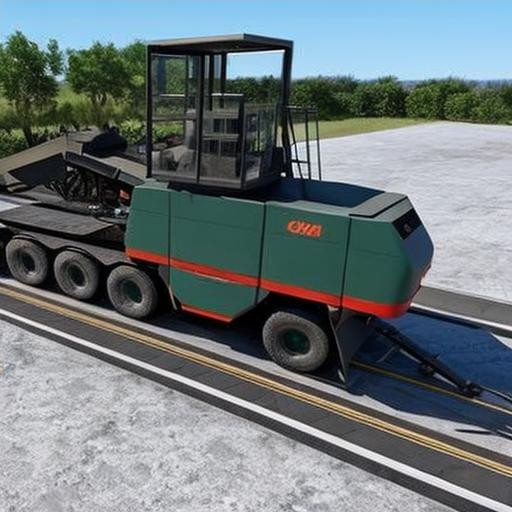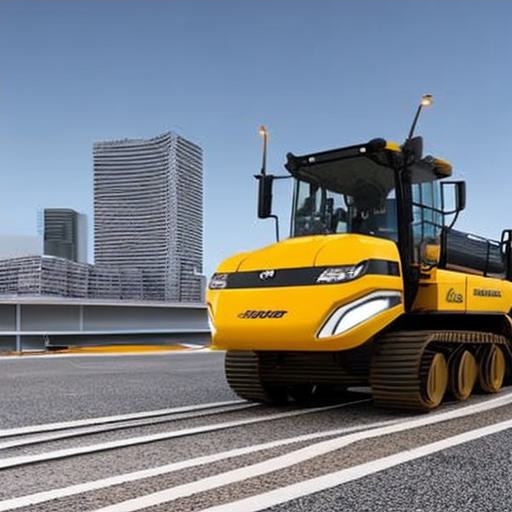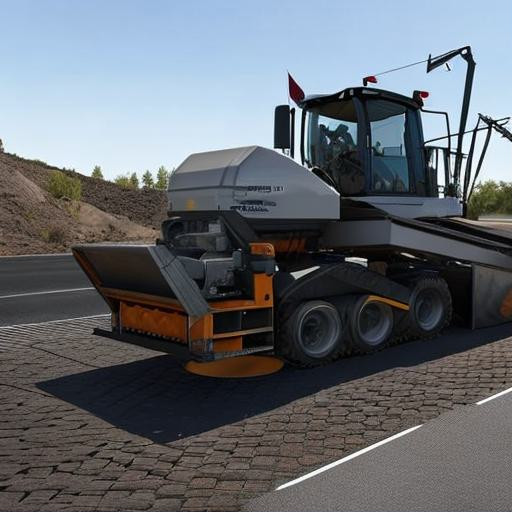

Asphalt and concrete pavers are crucial pieces of equipment used in the construction industry to lay roads, parking lots, and other flat surfaces. These machines are designed to distribute and compress asphalt or concrete to create smooth and level surfaces for vehicles and pedestrians to travel on. Asphalt pavers are primarily used for roads and highways, while concrete pavers are used for sidewalks, parking lots, and other concrete surfaces. Understanding the different types of pavers, their key components, and maintenance requirements is essential for construction companies to choose the right equipment and ensure their projects are completed efficiently and effectively.

There are different types of asphalt and concrete pavers that are used in construction projects based on their specific requirements. Here are the main types of pavers:
Choosing the right type of asphalt or concrete paver depends on the specific needs of the construction project. The type of paver used can impact the speed and efficiency of the project, as well as the quality of the finished product. Understanding the differences between the different types of pavers is essential for construction companies to choose the right equipment for the job.
Tracked asphalt pavers are commonly used in road construction projects where the subgrade might be unstable or uneven, and the paver needs to be able to move over different terrains. These pavers have tracks instead of wheels, which provide better traction and stability on rough or uneven surfaces. The tracks also distribute the weight of the paver evenly over a larger area, reducing the pressure on the ground, which is particularly important when the subgrade is not strong enough to support the weight of the paver. Tracked asphalt pavers are also preferred for their ability to pave steep grades, where a wheeled paver might struggle to gain traction and maintain stability.
Tracked asphalt pavers come in different sizes and configurations, depending on the specific needs of the project. The most common configuration is the two-track paver, which has a hopper for storing the asphalt, a conveyor for transporting the asphalt to the screed, and two tracks for moving the paver. Some larger tracked pavers have additional features, such as extendable screeds, which allow the paver to pave wider areas in a single pass, reducing the number of passes required to complete the job.
Maintenance of tracked asphalt pavers is essential to keep them running smoothly and prevent breakdowns. Regular maintenance should include cleaning the tracks to remove debris, checking and replacing the tracks when they show signs of wear, and inspecting and replacing the undercarriage components, such as the sprockets, idlers, and rollers, as needed. Regular maintenance of the engine, hydraulic system, and electrical system is also critical to prevent downtime and ensure the paver runs efficiently.
In summary, tracked asphalt pavers are an essential piece of equipment in road construction projects, where the subgrade might be unstable or uneven, and the paver needs to be able to move over different terrains. They provide better traction and stability than wheeled pavers, making them an ideal choice for rough or uneven surfaces. Understanding the different sizes and configurations of tracked asphalt pavers, as well as their maintenance requirements, is essential for construction companies to choose the right equipment for their projects and ensure they are completed efficiently and effectively.
Wheeled asphalt pavers are another type of asphalt paver commonly used in road construction projects. As the name suggests, they have wheels instead of tracks, making them easier to maneuver on flat, stable surfaces. They are ideal for smaller projects, such as parking lots and driveways, where the surface is relatively even and level. Wheeled pavers typically have four or six wheels and can be either self-propelled or towed by another vehicle.
Wheeled asphalt pavers have many of the same components as tracked pavers, such as a hopper for storing the asphalt, a conveyor for transporting the asphalt to the screed, and a screed for laying the asphalt. The difference is that the wheels provide the movement and stability needed for the paver to operate. They are typically lighter and smaller than tracked pavers, which means they can be transported more easily to job sites and require less space to operate.
Maintenance of wheeled asphalt pavers is similar to that of tracked pavers, with regular cleaning, inspection, and replacement of wear components. The wheels and tires require regular inspection and replacement as needed, as they are the main source of movement and support for the paver. The engine, hydraulic system, and electrical system should also be inspected and maintained to ensure efficient operation.
Wheeled asphalt pavers are an excellent choice for smaller projects where the surface is relatively flat and stable. They are typically more affordable and easier to transport than tracked pavers, making them a popular choice for smaller contractors or projects with limited space. However, they may not be suitable for larger, more complex projects with uneven or unstable terrain, where a tracked paver would be a better choice.
In summary, wheeled asphalt pavers are an excellent choice for smaller road construction projects where the surface is relatively flat and stable. They are typically more affordable and easier to transport than tracked pavers, making them a popular choice for smaller contractors. Regular maintenance of the wheels, tires, and other components is essential to keep the paver running efficiently and prevent breakdowns.
Concrete slipform pavers are specialized machines that are used to lay concrete pavements for roads, highways, and other large infrastructure projects. Unlike asphalt pavers, which use a hopper to dispense asphalt, concrete slipform pavers use a mold that shapes the concrete into the desired shape and size. The mold is adjustable, allowing for a range of pavement thicknesses and widths.
Concrete slipform pavers are typically self-propelled and use sensors to guide the machine along the designated path. They have a powerful engine and hydraulic system, which are essential to ensure the machine operates efficiently and consistently. They also have a large tank to store the concrete mix and a conveyor system to transport the mix to the mold. The mold is supported by a series of hydraulic legs, which can be adjusted to ensure that the pavement is level and smooth.
One of the main advantages of using concrete slipform pavers is their ability to lay large amounts of concrete quickly and accurately. The use of a mold ensures that the pavement is uniform and consistent, which is essential for large infrastructure projects that require high-quality concrete pavements. Concrete slipform pavers are also capable of laying complex shapes, such as curves and slopes, which would be difficult to achieve with traditional concrete laying methods.
As with other types of pavers, regular maintenance of concrete slipform pavers is essential to keep them running smoothly and prevent downtime. This includes regular cleaning of the machine and mold, inspection and replacement of worn components, and regular maintenance of the engine and hydraulic system.
In summary, concrete slipform pavers are specialized machines that are used to lay concrete pavements for large infrastructure projects. They use a mold to shape the concrete, which ensures uniformity and consistency in the pavement. They are capable of laying large amounts of concrete quickly and accurately, making them an essential piece of equipment in the construction industry. Regular maintenance is essential to keep the machine running efficiently and prevent breakdowns.
Concrete fixed form pavers are another type of concrete paving equipment used to lay concrete pavements for roads, highways, and other large infrastructure projects. Unlike slipform pavers, which use a mold to shape the concrete, fixed form pavers use pre-made forms to shape the concrete into the desired shape and size. These forms are usually made of steel or aluminum and are reusable.
Concrete fixed form pavers are typically towed by a tractor and have a series of hydraulic jacks that can be adjusted to ensure that the forms are level and at the correct height. The machine is guided by a string line or laser system, which ensures that the pavement is laid straight and to the correct grade. The concrete mix is typically transported to the machine in a separate mixer truck and is then dispensed into the forms through a conveyor system.
One of the main advantages of using concrete fixed form pavers is their ability to produce high-quality concrete pavements with a smooth finish. The pre-made forms ensure that the pavement is uniform and consistent, which is essential for large infrastructure projects. They are also capable of laying complex shapes and sizes, making them suitable for a wide range of concrete pavement applications.
As with other types of pavers, regular maintenance of concrete fixed form pavers is essential to keep them running smoothly and prevent downtime. This includes regular cleaning of the machine and forms, inspection and replacement of worn components, and regular maintenance of the engine and hydraulic system.
In summary, concrete fixed form pavers are an important piece of equipment for the construction industry, used to lay high-quality concrete pavements for large infrastructure projects. They use pre-made forms to shape the concrete, which ensures uniformity and consistency in the pavement. They are capable of laying complex shapes and sizes, making them suitable for a wide range of concrete pavement applications. Regular maintenance is essential to keep the machine running efficiently and prevent breakdowns.

Both asphalt and concrete pavers have several key components that are essential to their operation. Understanding these components is important for anyone working with these machines or looking to purchase one.
Each of these components is essential to the operation of asphalt and concrete pavers. Regular maintenance of these components is important to keep the machine running smoothly and prevent downtime. This includes regular cleaning, inspection, and replacement of worn components, and regular maintenance of the engine and hydraulic system.
In summary, understanding the key components of asphalt and concrete pavers is important for anyone working with or looking to purchase these machines. Each component plays an important role in the machine's operation, and regular maintenance is essential to keep the machine running smoothly.
When it comes to choosing between asphalt and concrete pavers, there are several important factors to consider. Each type of paver has its own unique advantages and disadvantages, and the decision should be based on a thorough understanding of the specific needs of the project and the requirements of the job site.
Here are some of the key considerations to keep in mind when choosing between asphalt and concrete pavers:
In summary, choosing between asphalt and concrete pavers requires careful consideration of a variety of factors. The decision should be based on a thorough understanding of the specific needs of the project and the requirements of the job site. By taking these considerations into account, it is possible to choose the best type of paver for the job and ensure a successful and durable pavement installation.

Maintenance and repair are essential for ensuring the longevity and performance of both asphalt and concrete pavers. Regular maintenance helps to prevent costly repairs and downtime, while timely repairs can extend the lifespan of the paver and reduce the risk of safety hazards.
Here are some key aspects of maintenance and repair for asphalt and concrete pavers:
In summary, proper maintenance and repair are essential for ensuring the longevity and performance of asphalt and concrete pavers. Regular cleaning, lubrication, and inspection, as well as timely replacement of worn or damaged parts, can help to prevent costly repairs and ensure the safety of the operator and the job site. Sealcoating and resurfacing can also help to extend the lifespan of the pavement and improve its appearance and performance.
Pavers are essential construction equipment for paving roads, parking lots, and other surfaces. The article discussed the different types of pavers, including tracked and wheeled asphalt pavers, and concrete slipform and fixed form pavers. The article also covered the key components of pavers, such as the screed and the hopper, and the considerations that should be taken into account when choosing a paver for a particular job. Regular cleaning, lubrication, and inspection, as well as timely replacement of worn or damaged parts, can help to prevent costly repairs and ensure the safety of the operator and the job site. Sealcoating and resurfacing can also help to extend the lifespan of the pavement and improve its appearance and performance.
Overall, asphalt and concrete pavers are critical tools for the construction industry, and understanding their different types, components, and maintenance requirements is essential for anyone working in the field.
Last Update: February 2023